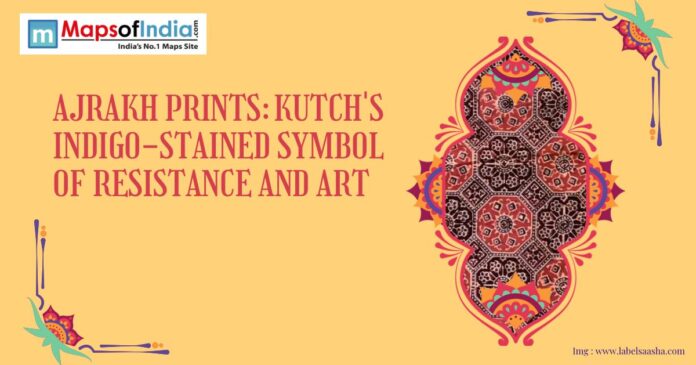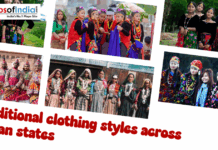In the dry lands of Kutch, Gujarat, there is a centuries old art form that still thrives, telling the stories of resilience, identity, and beauty through fabric. Ajrakh prints, which are well known for their intricate block printed patterns and deep indigo hues, are more than just textiles; they are a cultural symbol of the Khatri community and a symbol of resistance against past traditions. Started from the Indus Valley Civilisation, this craft has a combination of artistry with sustainability which uses natural dyes and meticulous techniques.
The Origins of Ajrakh
Historical background
Ajrakh, the term derived from the Arabic word azrak which means blue, shows its origins to the Indus Valley Civilisation. Which has evidence of block-printed textiles found in Mohenjo-Daro which dates back 4500 years. The craft flourished in Sindh now known as Pakistan, and the Kutch region which was carried forward by the Khatri community who migrated to India post-Partition. Ajrakh’s geometric patterns and resist-dyeing techniques reflect a blend of Vedic, Islamic, and Jain influences, making it a cultural mosaic.
Symbol of Resistance
Ajrakh has long been known as the symbol of resistance against colonial suppression of indigenous crafts, environmental challenges in Kutch, and modern industrialisation. During British rule the local craftsman preserved Ajrakh despite policies favouring machine made textiles. Today’s age resists cultural erosion, with craftsmen like the Khatri family in Ajrakhpur still keeping the craft safe.
The Artistry of Ajrakh Printing
Ajrakh is a complex block printing and resist dyeing technique requiring up to 16 steps, as noted by artisan Ismail Khatri. This process follows these steps:
Preparing Fabric: Cotton or silk is washed and treated with myrobalan as a natural mordant to increase dye absorption.
Avoiding Printing: Wooden blocks carved with intricate patterns are used to apply a resist paste of lime and gum arabic to prevent dye penetration.
Dyeing using Indigo: Fabric is dipped in natural indigo vats which are often sourced from Rajasthan which gives iconic blue hues.
Printing: Additional dyes like madder root which are red and iron rust which is black are applied.
Washing: The fabric is rinsed in flowing water which gives vibrant patterns.
Cultural and Social Significance
Community dynamics and Identity
The craft Ajrakh is deeply rooted in the Khatri community where families like the Khatris of Ajrakhpur pass down techniques across nine generations. The craft is increasing social bonds in communities with craftsmen collaborating in villages like Dhamadka and Ajrakhpur. It also holds significant ritual value with Ajrakh fabrics used in weddings and festivals across Gujarat and Sindh.
Empowerment of women
Women play an important role in the production of Ajrakh; they help from dyeing to finishing. A survey in 2024 showed that in Kutch 40% of Ajrakh artisans are women who also contribute to household incomes. Initiatives like Kala Raksha empower female workers and boost economic growth in rural Gujarat.
Environment Friendly Practices
The use of natural dyes, indigo, madder, and pomegranate in the making of Ajrakh supports the global trend of sustainability. The use of natural dyeing in fabric making reduces water pollution by 70%. Craftsmen also recycle wastewater and use solar drying which minimises environmental impact.
Circular Economy
By sourcing local materials and repurposing agricultural byproducts like myrobalan the craft of Ajrakh supports a circular economy. The emission of a low carbon footprint attracts environment-friendly consumers with 60% of Ajrakh exports targeting sustainable fashion markets in Europe and Japan.
Market Insights and Data
Growing Global Demand
The global market for handcrafted textiles reached $1.1 billion in 2024 with a projected compound annual growth rate of 7% through 2030. India’s handicrafting sector, which also includes Ajrakh, contributes 15% to this market. Google Trends data shows a 45% increase in searches for “Ajrakh prints” globally from 2023 to 2025. Most searches are from India and the US.
E-Commerce platforms and Social Media
Online buying and selling platforms like iTokri and Etsy report that each year a 35% rise in Ajrakh sales. This might have happened because of millennials seeking sustainable fashion. Instagram hashtags like #Ajrakh and #KutchCrafts have more than 600,000 posts. 50% of Ajrakh craftsmen now sell their product directly via social media.
Export Trends
Gujarat’s handicraft export market which also includes Ajrakh has recently reached $300 million in 2024 where Kutch contributes 20%. The US, UK, and Australia are top markets for buying Indian handmade products where Ajrakh sarees fetch $50–200 per piece. Government initiatives like One District One Product (ODOP) have boosted Kutch’s Ajrakh exports by 25% since 2022.
Challenges Faced by Ajrakh
Craftsmen Livelihoods
Despite being in demand in the global market the income earned by craftsmen is modest. According to a rural economy report which shows that 60% of people make less than ₹15,000 per month. Middlemen often take 30 to 40% of profits.
Skill Preservation
Younger generations are more interested in finding jobs in big cities which has risked the craft’s continuity. Only 10% of Kutch’s craft workers are under 30. Some NGOs held some training programmes.
Competition
Fibre made from synthetic prints and mass-produced textiles in the market is priced 50% lower compared with Ajrakh. Increasing awareness about its cultural and environmental value is critical to sustaining demand.
Opportunities for Growth
Digital Marketing
The use of E-commerce platforms and collaborations with influencers can lead to an increase in Ajrakh’s reach. A recent study has shown that Instagram campaigns have increased Ajrakh sales by 20% in six months.
Tourism in Craft Villages
Kutch’s craft villages like Ajrakhpur attract 50,000 tourists per year. Workshops and live demonstrations held by NGOs can boost sales of the product and lead to cultural appreciation.
Innovation
Craftsmen are experimenting with Ajrakh on new products like bags and upholstery which are appealing to urban consumers and help them to stay in trend. Collaborations with known designers as seen in Shelly Jyoti’s indigo art projects, help to boost Ajrakh’s global profile.
The Future of Ajrakh
The craft of Ajrakh which has a blend of heritage, sustainability, and artistry positions it as a global cultural asset. Going forward must have:
Artisan Welfare: A proper trade model with benefits for craftsmen, more than middlemen.
Proper Education: Proper education and training of the craft should be given to the younger generation.
Use of Technology: Use of upcoming technology for getting more advanced ideas as well as to reach a wider market.
Conclusion
Ajrakh prints are not just a craft of textiles. This is a Kutch’s indigo-stained legacy which shows resistance, artistry, and sustainability. From their ancient times to modern roads these fabrics tell a story of resistance and innovation. With growing global demand, digital platforms, and government support, Ajrakh has reached a global stage proving that traditional crafts can thrive in a modern world.




